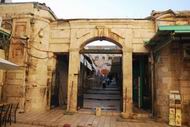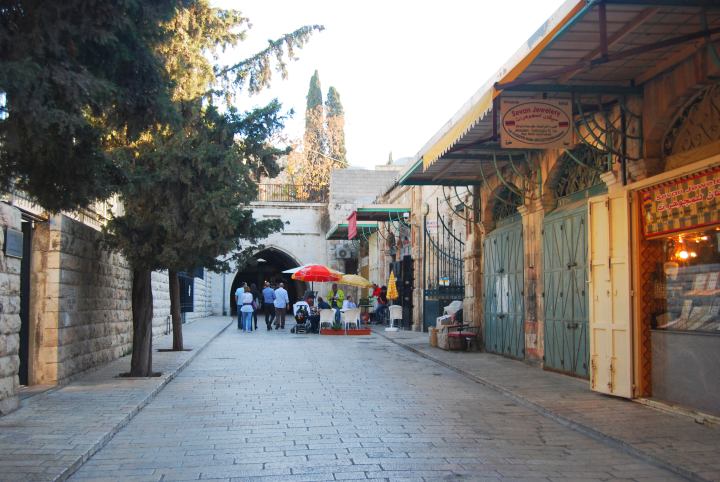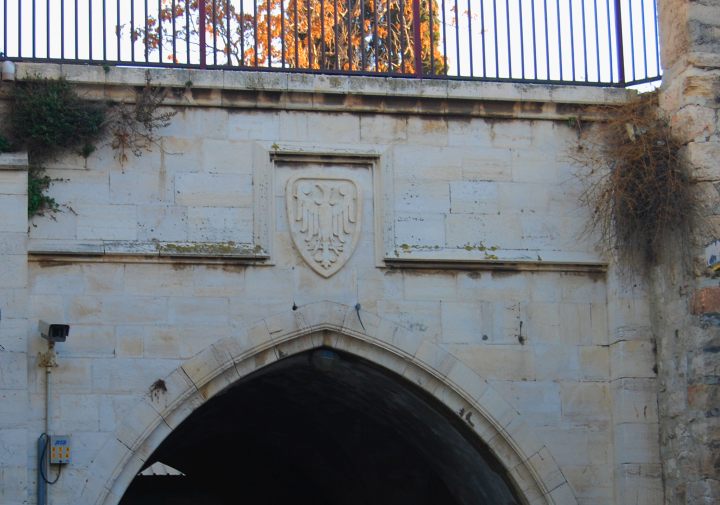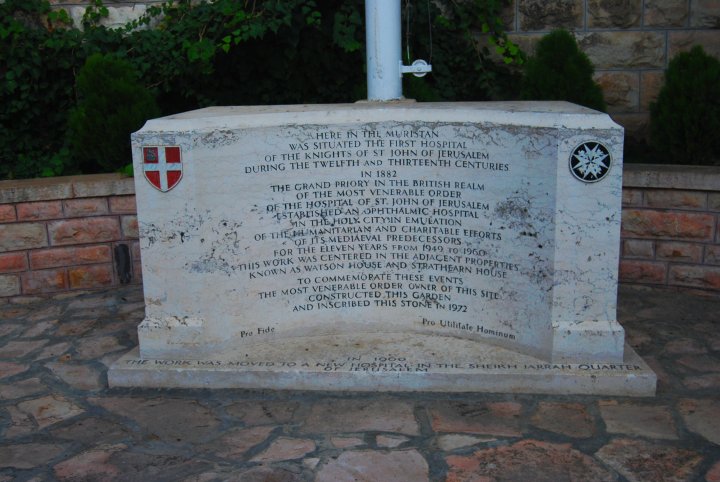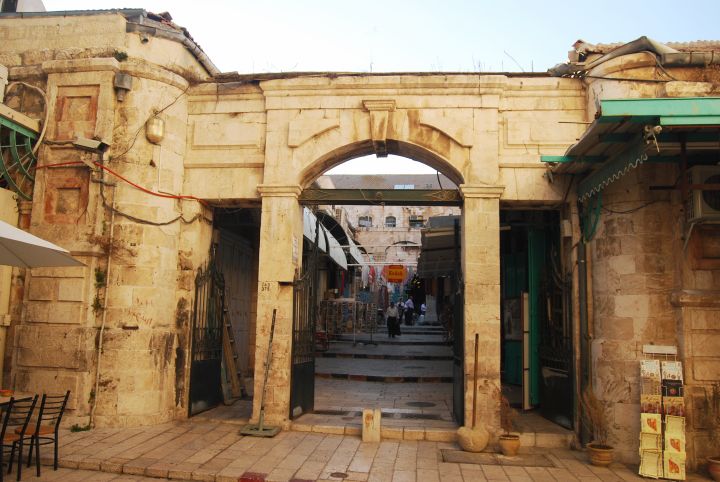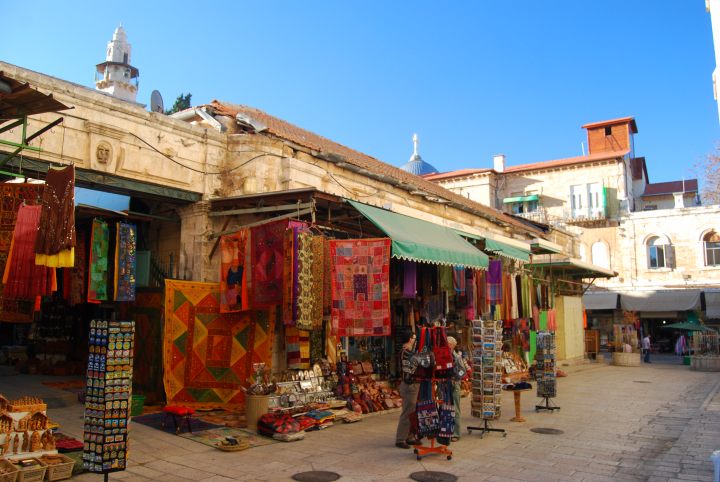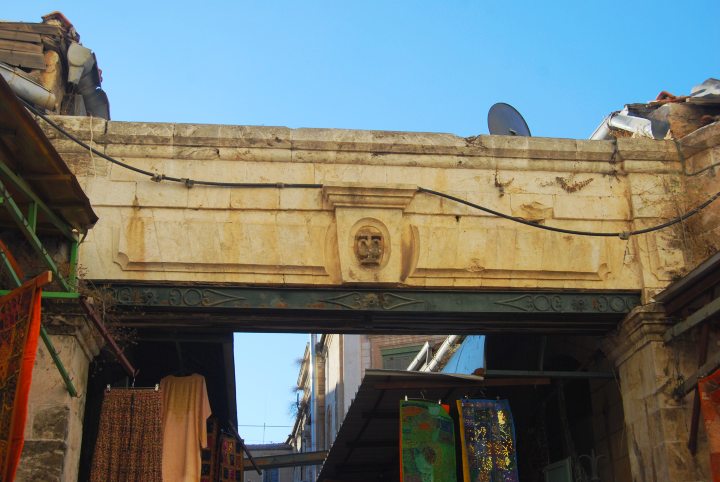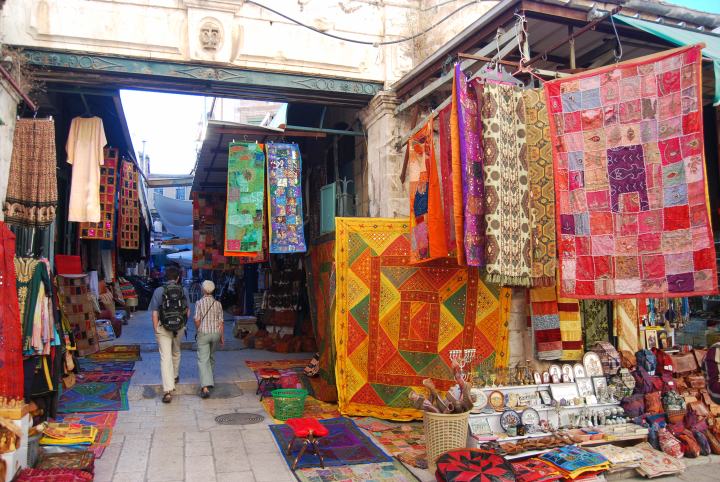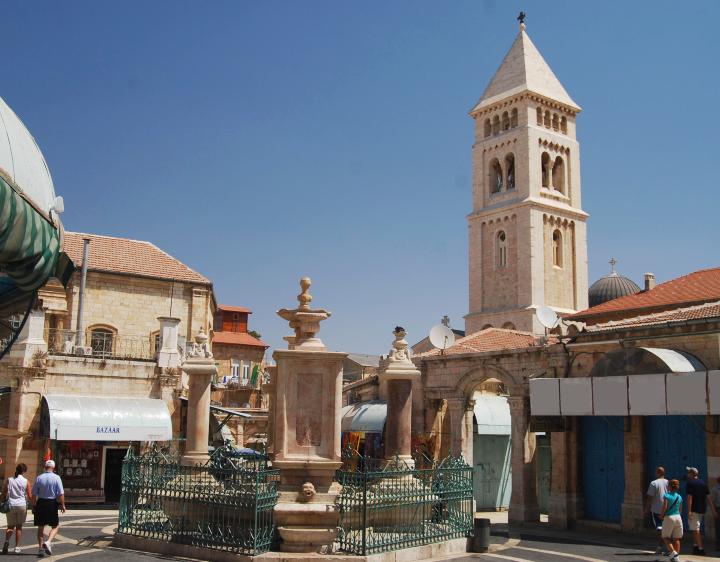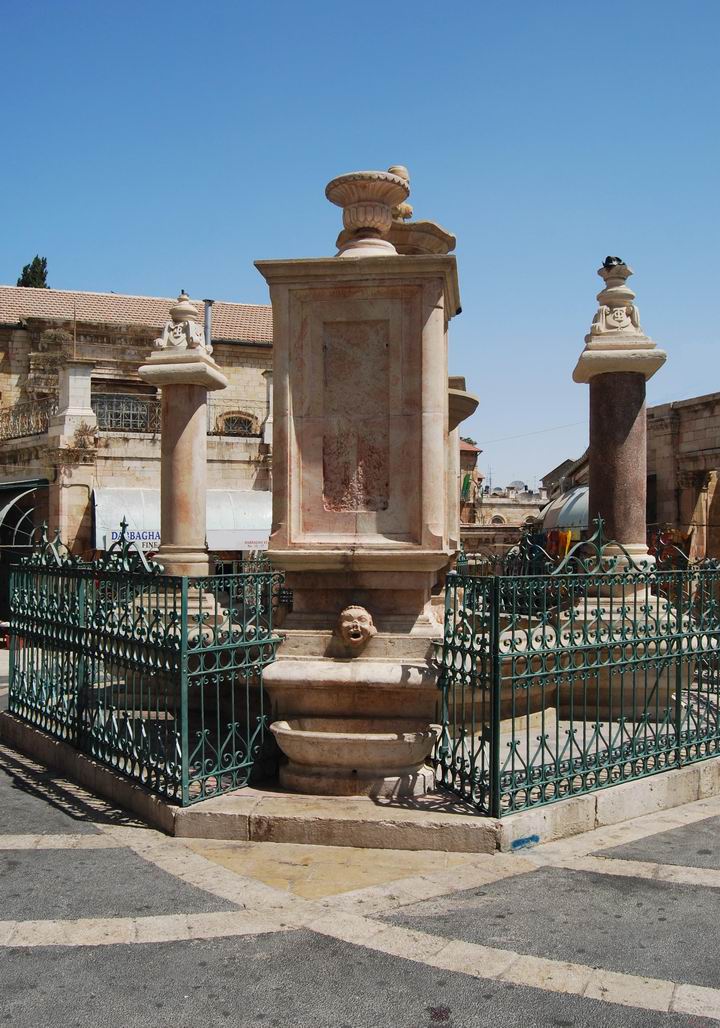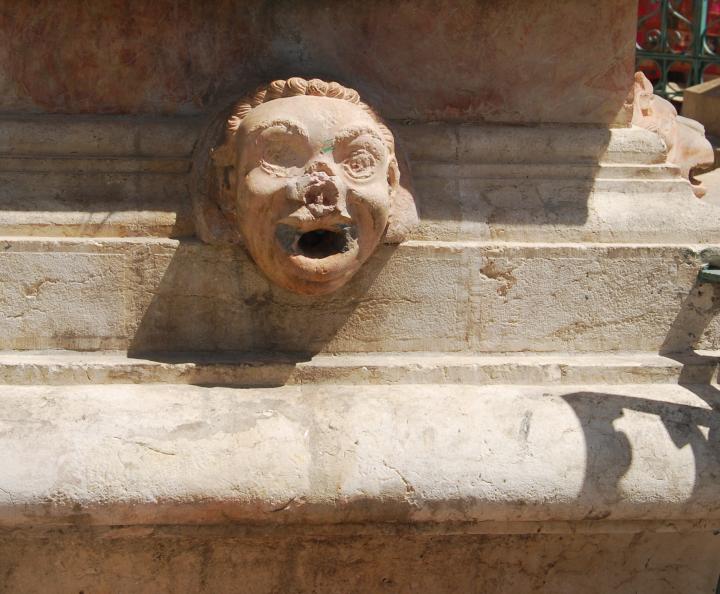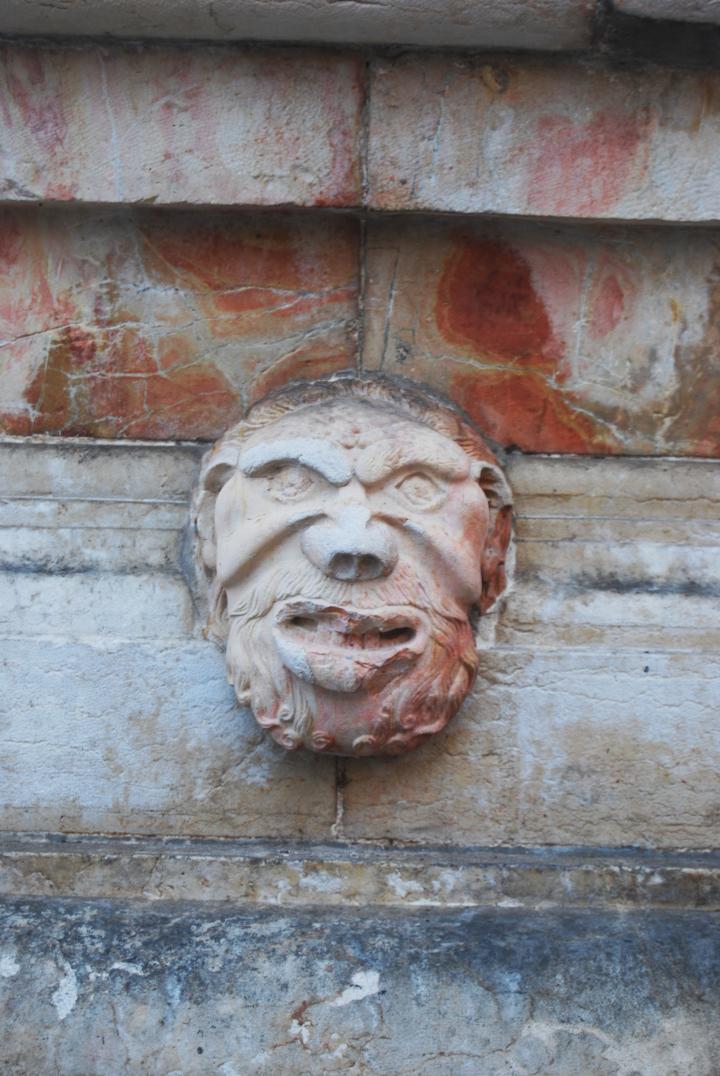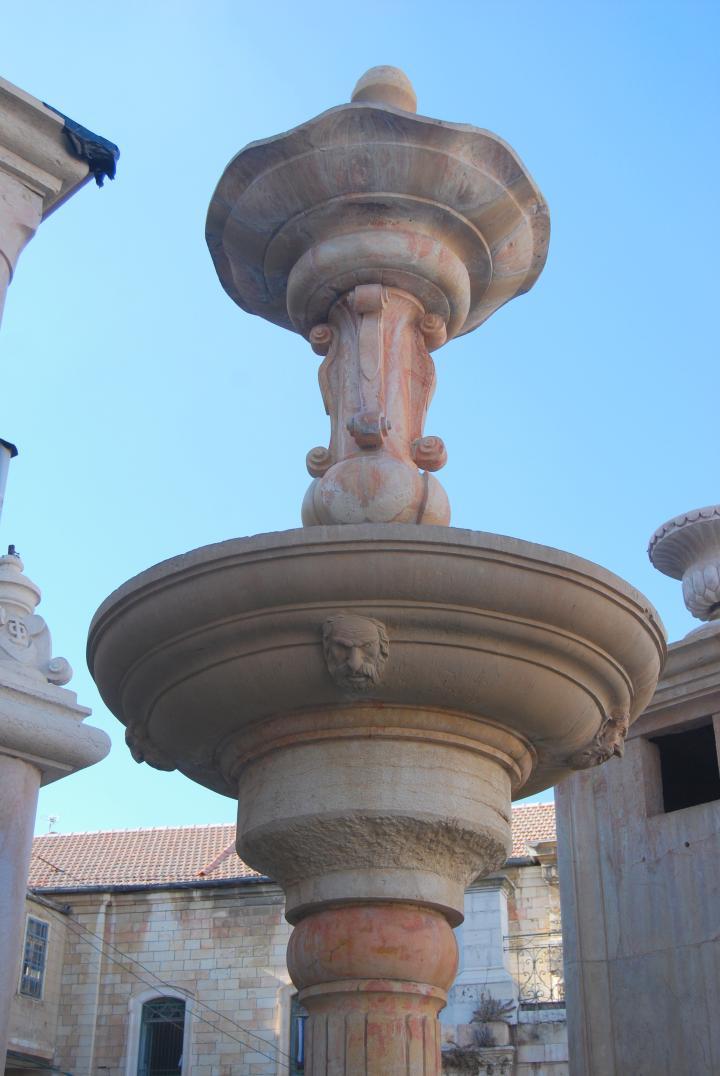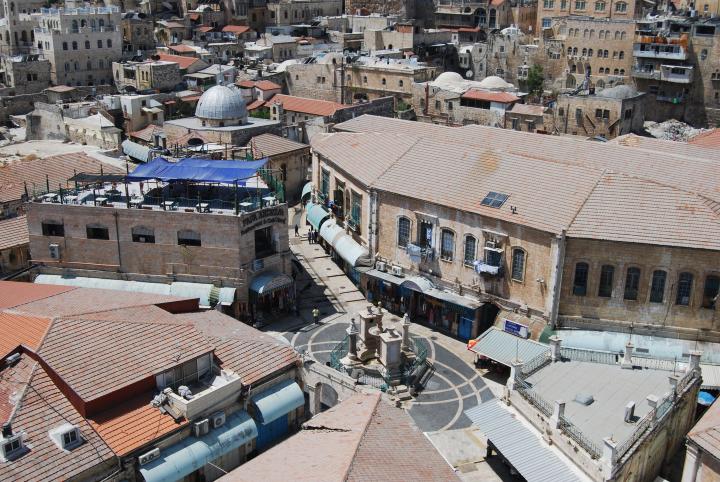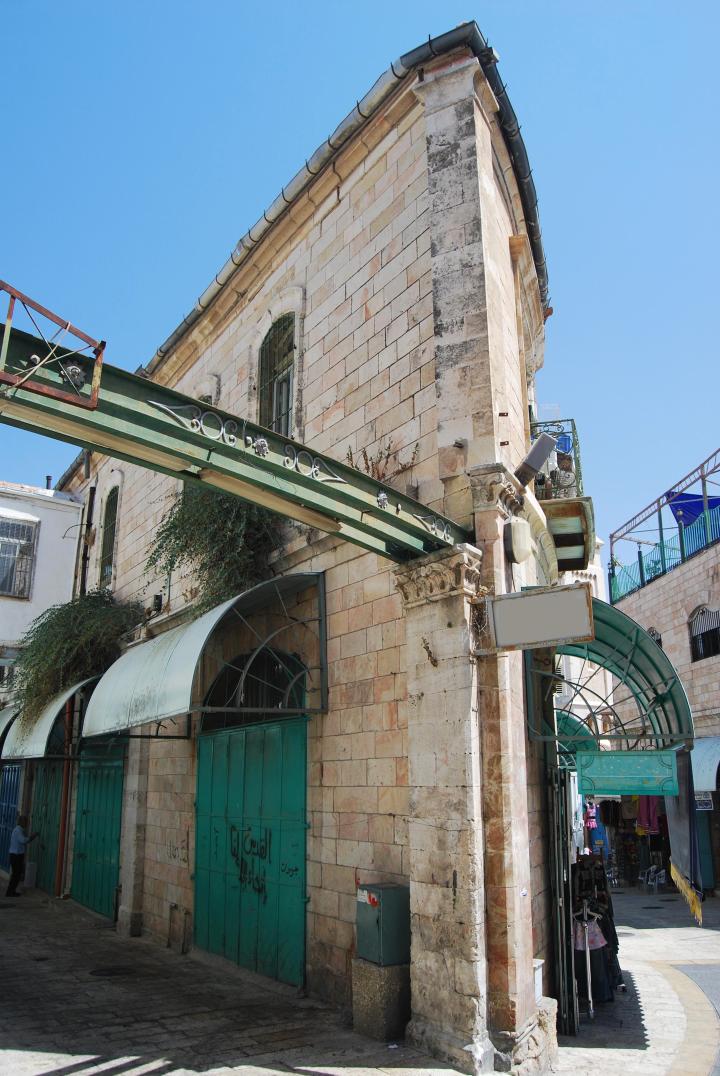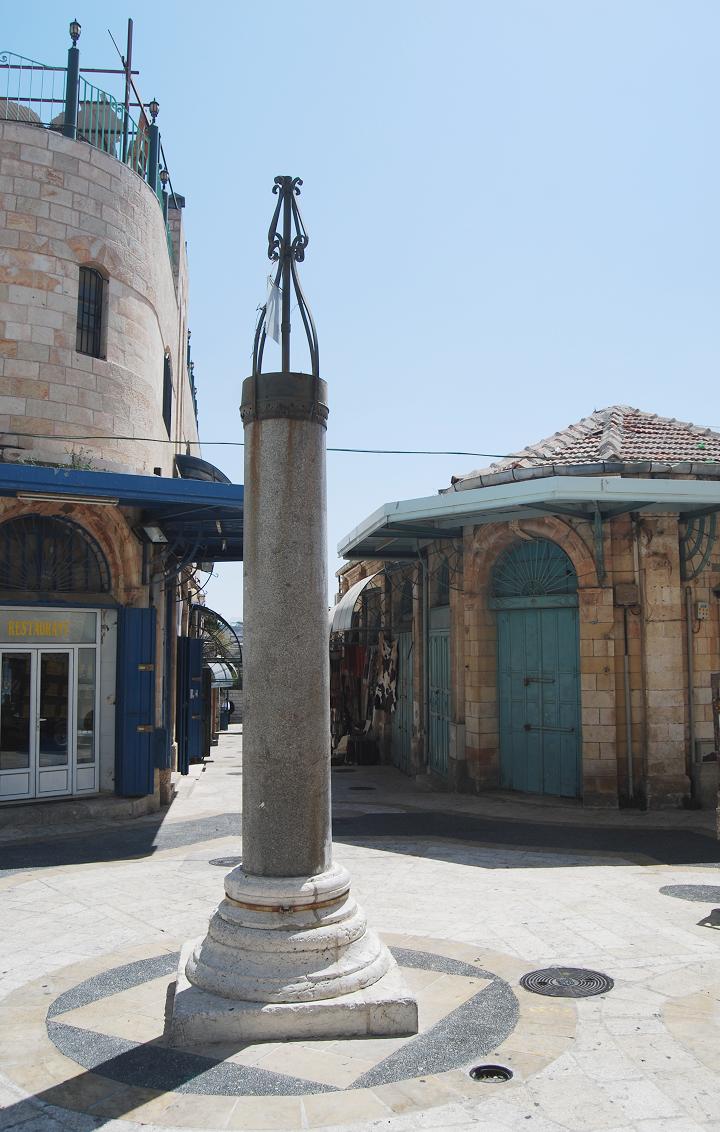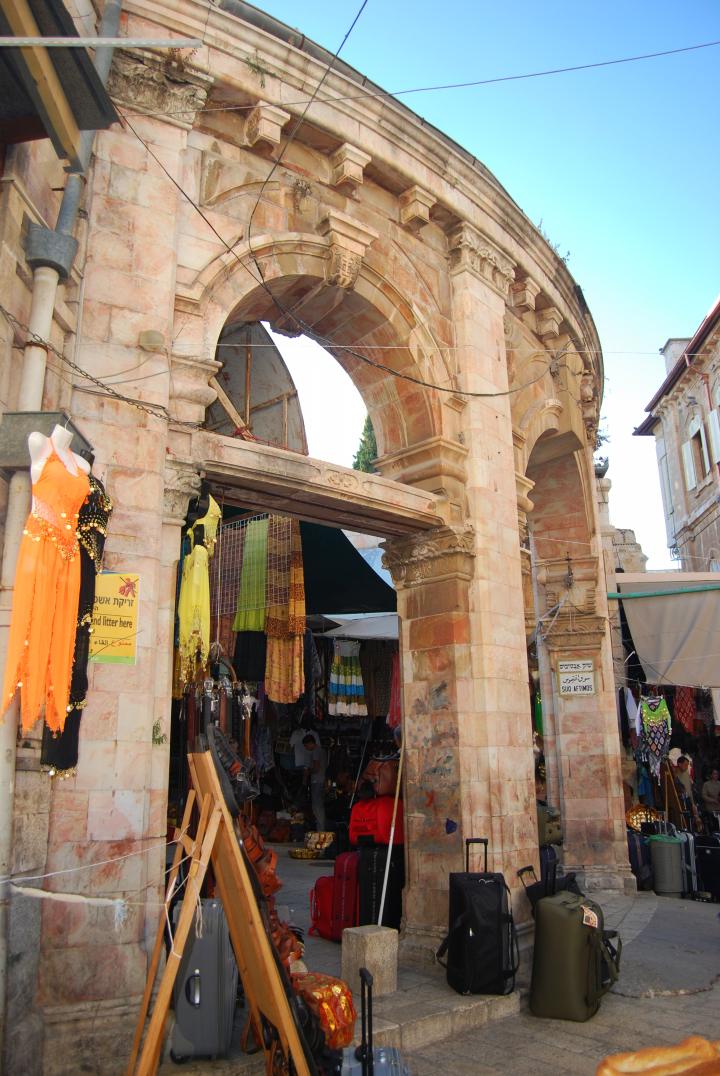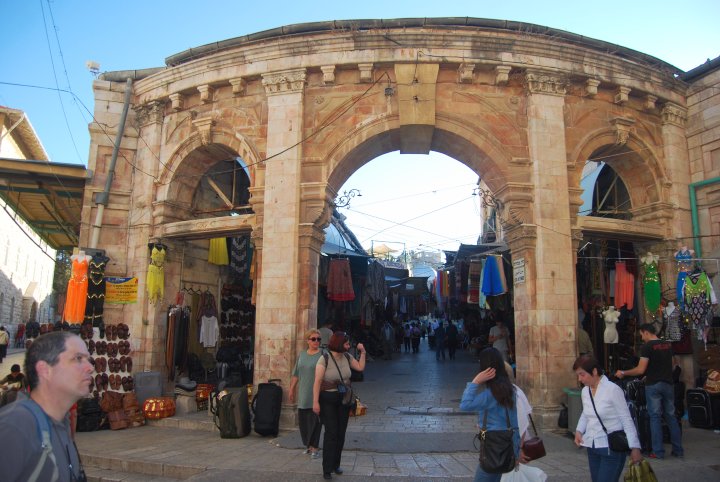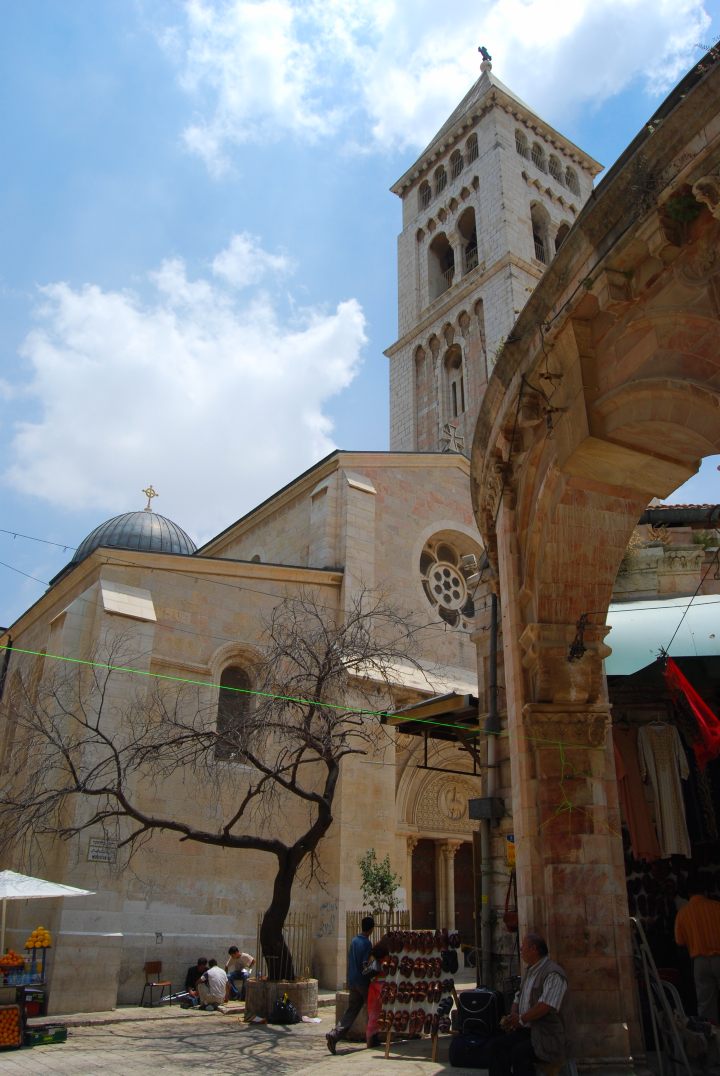An area in the Christian quarter, located on the site of the Crusaders Hospitallers quarters and hospital.
Home > Sites > Jerusalem > Muristan
Contents:
Overview
Old city gates
History
Photos
* Muristan
* Market
* Fountain
* South
* North
* Redeemer
Etymology
Links
Overview:
The Muristan is a section of the Old City of Jerusalem, located in the Christian Quarter. The name “Muristan” comes from the Persian word for “hospital,” and refers to the site’s history as a center of Christian healing and care.
The Muristan is believed to have been the site of the first hospital in Jerusalem, established by the Knights Hospitaller, a medieval Christian military order, in the 12th century. The Hospitallers provided care for the sick and injured, and their hospital became a major center of medical knowledge and training. The area surrounding the hospital was developed into a thriving market and commercial district, and the Muristan remains one of the busiest and most vibrant sections of the Old City to this day.
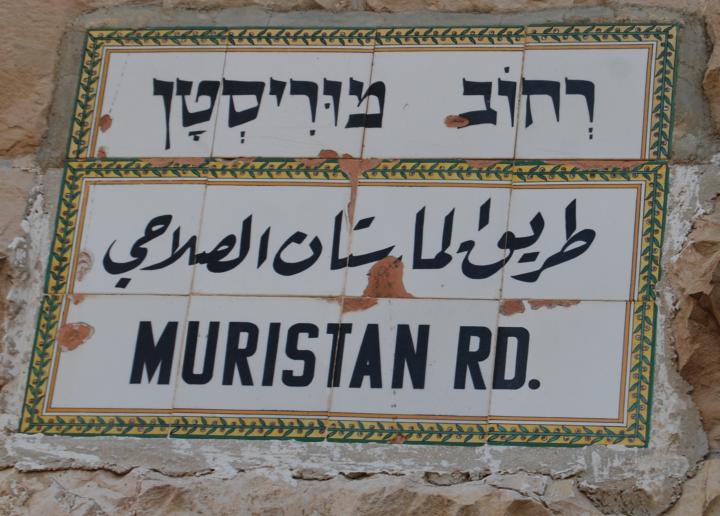
Location:
The size of the Muristan area is 17 Dunam, which is part of the Christian quarter inside the old city. The area is located between three churches – the Church of Holy Sepulchre (Sepulcher), the Hospitallers’ Church of St. John the Baptist and the German church of the Redeemer.
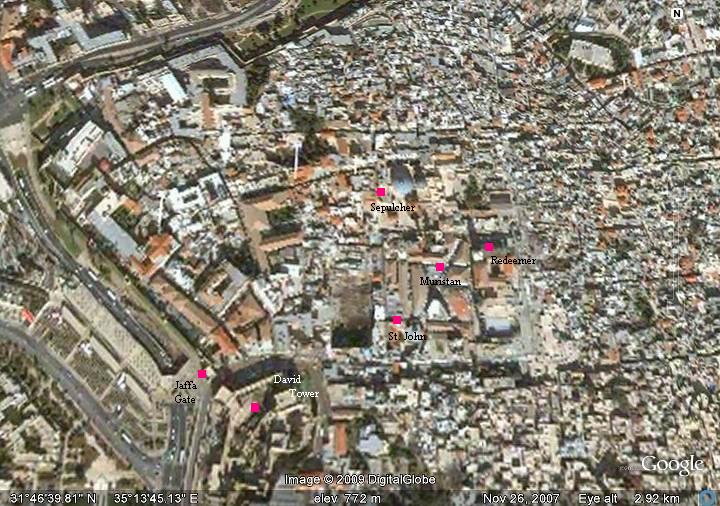
History of the place:
- Roman period
During the times of Jesus, the area of Muristan was outside the city walls, in an area which is the traditional site of Golgotha, the crucifixion and burial site of Jesus.
In the second century AD the Roman Forum was constructed in this area. This was the religious and political center of the Roman city of Aelia Capitolina (Jerusalem).
- Byzantine period
The ancient church of St. John the Baptist was built in the 5th century AD, and is one of the oldest in the Holy Land. It was dedicated to John the Baptist, and it is possible that the church presented some of St. John’s relics, including fragments of his skull. According to Orthodox tradition, his head was buried in this church.
The church was destroyed during the Persian or Arab conquest (7th century).
- Early Arab period
The Italian merchants from Amalfi established in the first half of the 11th century, during the Arab conquest, a Hospital and Church (“Santa Maria Latina”). They added later another Church (“Santa Maria Maggiore” – Saint Mary Major). These structures were built near the southern entrance to the Holy Sepulcher, in the area of Muristan. The arch of the Crusader gate is actually seen embedded on the north side of the Church of the Redeemer, which was built over its ruins.
- Crusaders period
The Italian church and hospice functioned as a hostel and a hospital to the wounded Crusaders during the conquest of Jerusalem in 1099.
Monks from the Benedictine order (Order of St Benedict) tended the sick and wounded warriors. This group evolved into a new local group that combined the religious zeal together with the Crusaders military life. The order, officially established in 1113 AD, named their order after John the Baptist, and were called the “Knights Hospitallers of St. John”, or commonly known as the Hospitallers. At the 11th C they purchased and renovated the nearby church and monastery of St John the Baptist, and their living quarters and the hospital structures were located around the present site called “Muristan” which is based on the Persian name for “hospital”.
In 2013 sections of this large hospital (15 Dunams!) were excavated, as part of a reconstruction work of the Crusaders structure, which will open to the public at the end of the year. The excavators reported that “Its construction is characterized by massive pillars and ribbed vaults and it stands more than six meters high” (IAA, Aug 2013). The building collapsed in the earthquake of 1457, and remained in ruins since then. Sections of the hospital were later reused as a stable and a market.
The Hospitallers became in the 12th century one of the important military orders defending the Holy Land. They established other structures and installations in the Holy Land, such as the knights halls in Acre.
- Late Ottoman period
The “Hospitallers quarter” area was ruined after the Mamlukes conquest (1267) until the late Ottoman period (19th C). Some of the monks continued to live in the ruins of the monastery of St John. In 1839 the monastery of St. John the Baptist was renovated by the Greek Orthodox church.
The eastern area of the Muristan was given as a present to the Prussian Crown Prince Friedrich Wilhelm, honoring his visit to Jerusalem in 1869. Wilhelm later became Emperor for a short time (1888), but reigned only 99 days and died due to illness. His son, Kaiser Wilhelm II (1888-1918), succeeded him as the German emperor. In 1898 he made an historic visit to the Holy Land with his his wife, Augusta Victoria. During this visit he dedicated the church of the Redeemer that the Germans built on this lot (1893 through 1898).
In 1903 the Greek-Orthodox Patriarchate of Jerusalem removed the ruins of the “Santa Maria Maggiore” church, and constructed the Greek market “Aftimos” (Avtimos).
- Modern period
Today, the Muristan is a popular destination for visitors to Jerusalem, and it is home to several important Christian sites, including the Church of the Redeemer, the Church of St. John the Baptist, and the St. Anne’s Convent. Visitors can explore the narrow, winding streets and experience the rich history and culture of this ancient quarter, and visit the many shops and markets that line the street. The Muristan is also a popular place to enjoy traditional Middle Eastern food and drink, and to watch the hustle and bustle of daily life in the Old City.
Photos:
(a) Muristan street:
A view of the Muristan road, towards the south.
The Muristan road used to be named after the Prussian Crown Prince Friedrich Wilhelm, honoring his visit to Jerusalem in 1869. The Prussian eagle symbol is located above the arch. The tunnel leads to David street (Suq El-Bazar).
On the left side of the street, on the entrance to the garden, is a monument which commemorates the site of the first Crusaders hospital (12th-13th century) as well as other events.
(b) The east side of the Market:
In 1903 the Greek-Orthodox Patriarchate of Jerusalem constructed on the western side of the lot a market, and removed the ruins of the “Santa Maria Maggiore” church .
This market is called “Suq Aftimos” (or, Avtimos), named after Euthymius, the 19th C Sacristan (door keeper, or property officer) of the “All Holy Church of the Resurrection” in the Holy Sepulcher, who managed the development projects in the Christian sector.
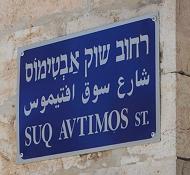
He was named after Saint Euthymius “the Great” (377-473 AD), a monk who resided in the Dead Sea area. The meaning of the name Euthymius is “good cheer”, so the Avtimos market can be translated to the “good cheer market”.
The Aftimos market includes 70 stores. It has an excellent location – the dome of the Holy Sepulcher can be seen in the center of the background in the photo below.
The symbol above the entrance is “TΦ” (Tau + Phi) meaning ‘taphos‘ or ‘Sepulchre’ – the Holy Sepulcher. This is the symbol of the Greek Orthodox church.
Another view of the colorful market.
(d) Fountain:
A grand fountain was designed in the center of the market, honoring the Sultan Abed al-Hamid II (18761909) reign of 25 years. It was constructed in 1903 in the newly designed market. It is seen below, with the bell tower of the Church of the Redeemer behind it.
A closer view of the fountain is seen below.
A detail of one of the six lower faces, slightly damaged, can be seen below.
Another “fountain-face” is seen below. This type of art is unusual in Jerusalem…
There are also four other faces on the top side of the fountain, as seen below.
(e) South side:
The south side of the markets borders with the Christian quarter street and St John the Baptist. A view from the bell tower of the Redeemer shows this section of the area. The fountain is seen in the center, and the dome of St John is seen on the top left side.
There are some nice structures in this area, as in the photo below.
A decorated pillar is located near the Church – one of several in the market – adding to the unique view of the Muristan area.
(f) North side:
The north corner of the Aftimos market is seen below.
Another view of the north corner of the market, near the German church.
Webmaster Rotem: Uncle Ronnie is observing the view on the left side.
(g) Church of the Redeemer:
The eastern area of the Muristan was given as a present to the Prussian Crown Prince Friedrich Wilhelm, honoring his visit to Jerusalem in 1869. The photo below shows the structure which was built on the east side of the market – the grand Church of the Redeemer with the tallest bell tower in the old city.
![]() For more information on the Church of the Redeemer – visit its web page.
For more information on the Church of the Redeemer – visit its web page.
Etymology (behind the name):
-
Muristan – The name of the area, based on the Persian word for hospital (“Bimarestan”), since the site is located over the ruins of the Crusaders-period hospital.
-
Colonia Aelia Capitolina – Named by Hadrian in 136AD; Aelia – after his family’s name; Capitolina – after Jupiter’s second name (Capitolinus)
-
Aftimos (Avtimos) – The market is named after Euthymius, the 19th C Sacristan (door keeper, or property officer) of the “All Holy Church of the Resurrection” in the Holy Sepulcher, who managed the development projects in the Christian sector. This Sacristan was named after the 4th C Saint Euthymius. The meaning of the name Euthymius is “good cheer”, so the Suq (market) Avtimos can be translated to the “good cheer market”.
Links:
* Muristan:
-
Crusader Remains in the Muristan, Old City of Jerusalem: A Decade of Archaeological Gleanings (Atiqot 66, 2011; pp. 137153): “…During excavations at the site, remains pertaining to these architectural units were discovered, including massive piers and ashlars, displaying typical Crusader diagonal tool marks, and stones bearing mason’s marks…”.
-
Old Hospital excavated in Muristan (IAA publication)
* Other Links:
- History of the Jerusalem Patriarchate
BibleWalks.com – walk with us through the sites of Jerusalem
Sisters Lady Zion<<<—previous site–<<< All Sites >>>—next Jerusalem site–>>> Redeemer
This page was last updated on Feb 11, 2023 (updated overview and modern period)
Sponsored links:
